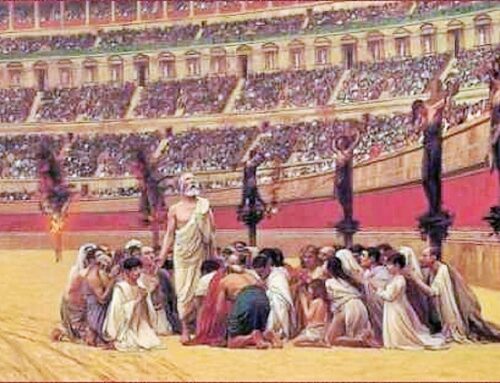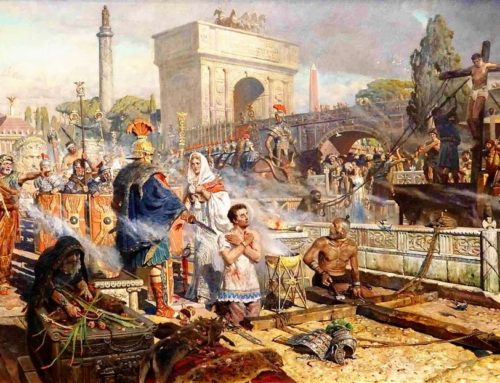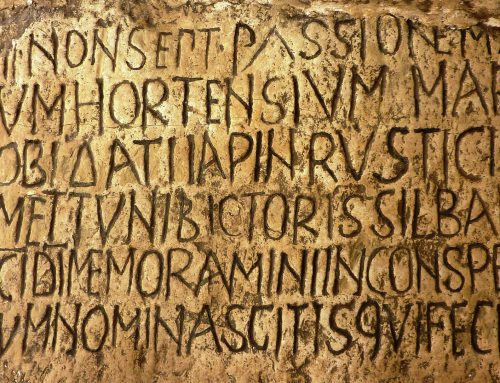The Church continues to make Christ present in human history. In the history of the Church, we find the divine and the human closely intertwined.
The Church continues to make Christ present in human history. In the history of the Church, we find the divine and the human closely intertwined.
The French Revolution, which started with deportation of the lower clergy, subsequently took on a clearly anti-Christian agenda: the establishment of worship of the Supreme Being, the abolition of the Christian calendar, etc., and in the end a cruel persecution of the Church (1791-1801). Pope Pius VI died in 1799 while a prisoner of the French revolutionaries. The rise to power of Napoleon Bonaparte, who was always very pragmatic, brought religious peace with the signing of the 1801 Concordat. But later, with Pius VII, disagreements arose due to the constant intrusions by the French government in the Church’s life. As a result, the Pope was taken prisoner by Bonaparte for nearly five years.
With the restoration of the pre-revolutionary monarchies in 1815, a period of peace and tranquility returned for the Church. But soon a new ideology arose that was deeply opposed to Catholicism—liberalism. Heir to the ideas of the French Revolution, it gradually succeeded in establishing itself as a political force promoting legislation that discriminated against and even persecuted the Church. Liberalism allied itself with nationalism in many countries, and later, in the second half of the century, with imperialism and positivism. All of these forces eventually contributed to de-Christianizing society. As a reaction to the social injustices caused by the liberal legislation policies, new ideologies sprang up, seeking to give voice to the aspirations of the classes oppressed by the new economic system: utopian socialism, “scientific” socialism, communism, and anarchism, all with the goal of social revolution and with an underlying materialistic bent.
In almost every country, Catholicism in the nineteenth century lost the protection of the state, which often became an adversary. In 1870 the popes’ temporal power came to an end with the Italian conquest of the Papal States and the unification of Italy. But at the same time, the Church was able to take advantage of this crisis to strengthen the union of all Catholics around the Holy See and to free itself from the intrusions by state authorities in the internal government of the Church. This culminated in the solemn declaration of the dogma of papal infallibility in 1870 by Vatican Council I, which took place during the pontificate of Pius IX (1846-1878). During this century, moreover, the Church was blessed with a great missionary expansion in Africa and Asia, the foundation of many women’s congregations of active life; and the organization of a widespread lay apostolate.
In the twentieth century, the Church was confronted by many challenges. Pius X was forced to counteract modernist theological tendencies within the Church. These currents, in their most radical manifestations, were characterized by a religious inmanentism; even when they kept the traditional formulations of the faith, in reality they emptied these of their traditional content. Benedict XV faced the calamity of the First World War; he maintained a policy of impartiality towards the contending parties and organized a humanitarian effort on behalf of war prisoners and the population suffering from the conflict. Pius XI opposed the various forms of totalitarianism that persecuted the Church more or less openly during his pontificate: communism in the Soviet Union and in Spain, national-socialism in Germany, fascism in Italy, and masonry in Mexico. This Pope also fostered the vocation of native priests and bishops in the missionary territories of Africa and Asia. This effort, continued by his successor Pius XII, enabled the Church to show its solidarity with peoples undergoing decolonization, rather than appearing as a foreigner.
Pius XII had to face the terrible trial of the Second World War, during which he acted in a variety of ways to save as many Jews as he could from Nazi persecution. (According to some people’s calculations, the Church saved approximately 800,000 lives). With a sense of realism, he did not consider it opportune to issue a public condemnation since this would only have worsened the grave situation of Catholics who were also being persecuted in various territories occupied by the Germans; such a denunciation by the pope, moreover, would have made it all but impossible for him to intervene successfully on behalf of the Jews. Many prominent Jews after the War publicly acknowledged the great merit of this pope’s help for their people.
John XXIII convoked the Second Vatican Council (1962-1965), which was closed by Paul VI. This Council opened up a new pastoral era in the Church, by stressing the universal call to holiness, the importance of ecumenical effort, the positive aspects of modernity, and the broadening of dialogue with other religions. During the years following the Council, the Church suffered a profound internal crisis, both doctrinal and disciplinary. The long pontificate of John Paul II (1978-2005) helped to counteract this crisis; he was a pope with an extraordinary personality who raised the Holy See to a level of popularity and prestige unknown before, both inside and outside of the Catholic Church.
OpusDei.uk





Leave A Comment
You must be logged in to post a comment.